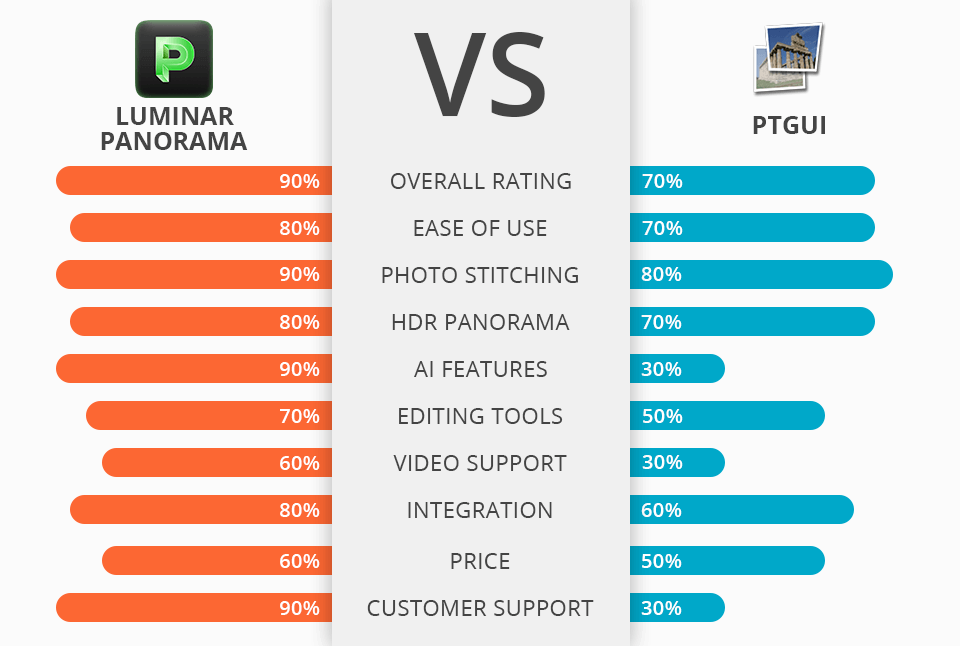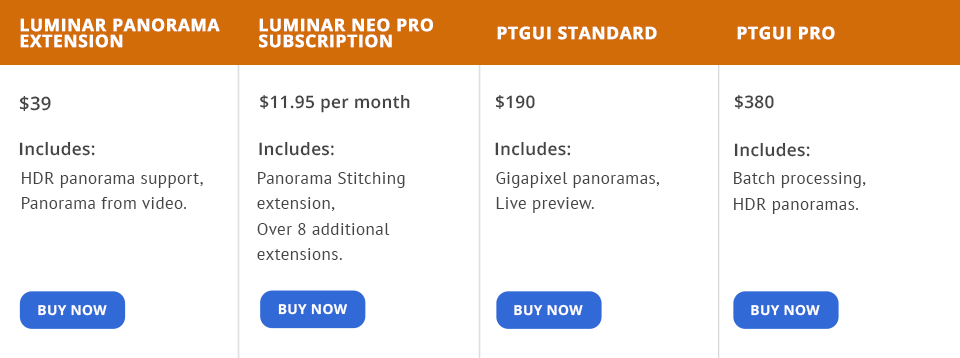Make sure to read this Luminar Panorama vs PTGui comparison, if you want to find an all-in-one solution for creating panoramic images by stitching photos together. Using photo stitching software like these, you can generate panoramas easily, even though they have different sets of tools.
Luminar Panorama was created by Skylum to facilitate the task of creating panoramic photos by stitching frames. With it, you can easily create panoramas without mastering professional third-party software.
At the same time, PTGui is based on an impressive blending algorithm. It ensures that seams will become virtually invisible in photos. Using it, you can streamline your workflow and create panoramic pictures of high-contrast landscapes.
What is Luminar Panorama?
Panorama Stitching is a useful extension of Luminar Neo, that enables users to generate panoramic stills from photos and videos. You can use it to capture wide-angle views, including landscape photos, portraits, and pictures of cityscapes.
1/2

1/2

2/2
Luminar Panorama: Pros and Cons
Tools for creating a panorama from video. The Panorama from Video feature allows users to use motion files to generate panoramic photos from videos. Using this extension, you can extract frames from your video to stitch them together and create a panoramic image.
HDR panorama. This tool is similar to the stitching feature but it allows you to fix the lighting issues in your photo by combining photos with different exposures and pano brackets into one HDR photo. The output image will be extremely detailed and contain both bright highlights and dark shadows.
Object and subject composition. What makes Luminar Panorama different from PTGui is that it enables you to select different subjects in a video and create a panoramic photo by selecting specific frames. It also allows you to focus on a specific object in the frame.
Realistic sunrays effects. Using this Luminar Neo feature, you can add the rays of sunshine to your photos and adjust their intensity. This tool analyzes the details of your photo and ensures that light falls naturally through clouds and trees. It allows you to achieve the most realistic result.
Easy-to-adjust fog tools. Atmosphere AI allows you to select from different types of fog, including layered fog, mist, and haze. Besides, you can adjust the intensity of the effect using sliders. It will allow you to adjust its depth and give an atmospheric feel to your photos.
Quick sky replacement. You no longer need to spend a lot of time on replacing the sky in your photos, as Sky AI will automatically perform this task while making reflections in water look unrealistic. You can use this tool to change the color of the sky and the shapes of clouds.
Pro-level editing tools. Besides RAW format, the program supports other formats as well. You can edit your images using masks and layers, which makes Luminar Panorama the perfect tool to consider. Besides, you can read Luminar tutorials to discover how to use the tools available in this software.
Only for powerful computers. If you have an old computer, you might get annoyed with the slow performance of Luminar Panorama as it requires an advanced hardware configuration.
No mobile photo editing app. Luminar Panorama doesn’t have a mobile app, which makes it less convenient for those who want to edit their photos on the go. Using the Luminar Share app, you can only connect your desktop computer to your smartphone. PTGui also doesn’t have a dedicated app.
What is PTGui?
PTGui is a useful option for those who are interested in landscape photography, as it allows users to stitch panoramas to create 360-degree pictures with unlimited resolution.
You can use it to create gigapixel photos if necessary. Besides, this software automatically fixes tilt, vignetting and exposure issues, which makes it a great option to consider.
1/2

1/2

2/2
PTGui: Pros and Cons
HDR effect. Just like Luminar Panorama, PTGui also allows users to create HDR panoramas. Besides, you can leverage top-level tone mapping and exposure fusion algorithms. This program also comes with an interactive panorama viewer. You can either use it to view files on your computer or embed a panorama on a page of your website.
Supports batch processing. It makes it an excellent option for any professional who needs to create many panoramas, for instance, when doing stop motion photography. Besides, PTGui allows you to notice and perform exposure fusion without using dedicated third-party tools.
Little planet panorama format. If you don’t know which option suits your needs best, Luminar Panorama or PTGui, keep in mind that the latter enables you to create different types of panoramas, such as equirectangular projections for spherical panoramas, rectilinear for architectural shots with straight lines, and stereographic panoramas that allow you to achieve the Little Planet effect.
Impressive output quality. PTGui supports impressive sharpness and seamless blending, which is why you won’t even notice the places where your panorama was stitched. The stitching tool is automated, which will save you a lot of time. However, sometimes, it can’t stitch objects properly, which makes this software a worse option than Luminar Panorama.
Plenty of tools for editing panoramas. PTGui allows you to move your panoramas and rotate them along the projection surface. You can select the center point manually or automatically as well as make the horizon straighter. However, the number of available tools might seem limited to those who prefer Luminar Panorama.
Compatibility issues. Unlike Luminar Panorama which integrates with different programs, PTGui doesn’t function well when you use it with such professional photo editing software as Photoshop and Lightroom.
Outdated UI. If you take a look at the well-thought-out and easy-to-navigate UI of Luminar Panorama, you will see that the interface of PTGui UI is a bit dated and difficult to use due to a large number of tools that most people won’t even need to utilize.
Luminar Panorama vs PTGui: Prices

Luminar Panorama has a monthly and annual subscription. You can choose between Pro and Ultimate plans as well as buy other extensions. If you have lifetime access to Luminar Neo, you can also pay extra to buy the Panorama Stitching extension. Alternatively, you can opt for one of the subscription plans.
You have to pay $129 for the Lifetime License of Luminar Neo. In this case, you will be able to use Panorama Stitching for free. The Pro Subscription costs $11.95 per month. It allows you to use all other extensions and features, including Luminar Neo. If you already have Luminar, you can purchase Panorama Stitching for $39.
If you compare Luminar Panorama vs PTGui, you will see that the latter also offers different types of licenses. You can either buy a standard license or purchase the Pro one. To get the Standard Personal License, you have to pay $190. If you want to edit batches of images and apply an HDR effect, you can pay $380 for the Pro Personal License. The Company License costs from $335 per year.
Luminar Panorama vs PTGui: Who Wins?
Luminar Panorama is a handy extension that allows users to merge up to 100 pics without wasting much time. Using it, you can quickly create a panorama to capture the beauty of your favorite landscapes. Besides, you can use Luminar Neo with Adobe Photoshop as it has a plugin version.
PTGui stands out for the excellent quality of output photos and a choice of tools for controlling stitching with better precision. However, while you can automate the processes using the available tools, it might be difficult to use this software with little to no experience. Besides, it doesn’t have some tools available in Luminar and doesn’t support in-depth edits or AI-driven features.



